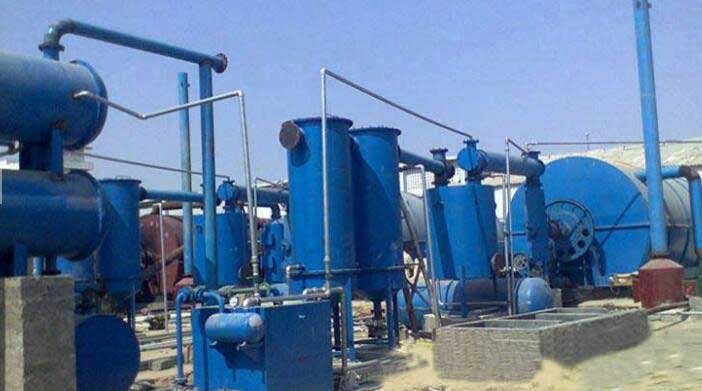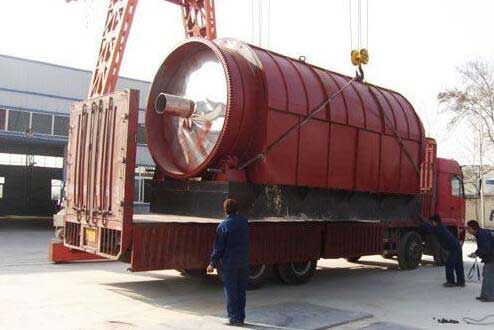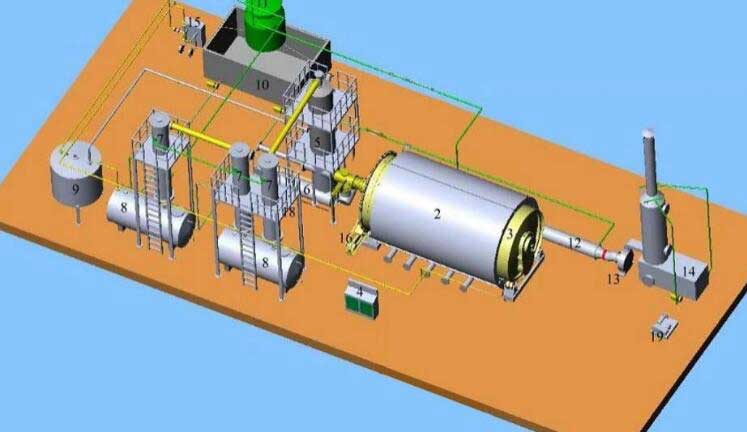Machine converting rubber tyres into energy in highly profitable green projects is a hot new topic as the amount of waste products in the world is on the increase, while energy resources are sharply decreasing. The problem of how to dispose of this huge amount of waste has ignited the interest of more and more people willing to invest in new green technology such as new pyrolysis plant setup which recycle and transform waste products into energy resources such as oil and diesel. Most of the fuel that comes from the TYRES TO OIL PROCESS is in the form of gas which can be re-used for burning fuel, turning waste into wealth. Moreover, as this waste gas is not expelled into the air, it protects the environment from pollution. This process is also called as the refining tyre oil or extraction of tires oil.
What Is A Pyrolysis Plant?
The pyrolysis tire recycling system is composed of the following 13 parts:
1. Reactor
2. Catalytic chamber
3. Transmission device
4. Heavy tank
5. Cooling tube
6. Condenser
7. Oil/water separator
8. Safety device
9. Light oil tank
10. Vacuum system
11. Draft fan
12. De-dusting system
13. Chimney
Two key parts of a tyres recycling plant are: the cooling system and the reactor.
The reactor is directly related to the safety and service life of the plant. Made from welded steel plates, the quality of welding has a direct impact on the safety and longevity of the reactor. The use of automatic welding machines, X-ray detection and heat treatment greatly improves working efficiency by guaranteeing the quality of welding.

The cooling system consist of two parts, the cooling pipe and the condensers. There are 3 condensers with 57 pipes in each condenser. The pipes have a diameter of 48mm. with a heat exchange area of 13 sq.m per condenser, producing a total cooling area of approximately 40 sq.m – which guarantees a high oil yield.
Main Features Of Pyrolysis Plant
Safety
– Automatic welding on the reactor greatly improves working efficiency of the plant; and guarantees the quality of the welded seam, thus avoiding the risk of an explosion from a leak.
– X-Ray detection and professional heating treatment especially designed for welding improves safety.
– A vacuum system prevents gas from oil re-entering the reactor and causing an accident.
– Special devices such as a pressure gauge, a safety valve and a thermometer ensure safety.
– To avoid the dangers of burning exhaust gas from C1 to C4, safety measures are used in the process by first transferring exhaust gas through a safety device and a safety burner air muzzle, ensuring safety during production. Check out homepage of Kingtiger for details.

Environmentally Friendly
– The well water De-dusting system avoids excessive and black smoke.
– Pollution is reduced by recycling exhaust gas for heating the reactor.
– Every reactor junction is maintained in good sealing condition with professional sealing material to prevent leaking. Find more information on environmentally friendly, you can see our page of plastic to diesel machine for sale.
Service Life
– Long service life is ensured by special Q245R,14mm thick steel plates.
– Automatic welding, heating treatment and X-Ray detection ensures maximum service life of the reactor to 8 -10 years.
Energy Saving
– Quality sealing for the heating system prevents gas leaks and saves fuel.
– Recycled exhaust gas is used for heating the reactor.
The end products of pyrolysis in the form of oil can be used as fuel in industrial furnaces and boilers and also to generate electricity. It reduces the hazards of land pollution from waste tyres and rubber by converting rubbish into energy and rids the environment of harmful non bio-degradable waste.
